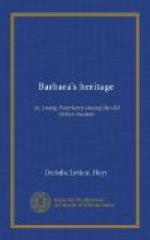“Come here,” said he, rising, “and see an example of this Greek Byzantine art,—this Magdalen. Study it well.”
“Oh, oh, how dreadful!” chorussed the voices of all.
“Uncle Rob, do you mean to say there was no painting in the world better than this in the ninth—or thereabouts—century?” asked Malcom, with wondering eyes.
“I mean to say just that, Malcom. But I must tell you something more about this same Greek Byzantine painting, for there is a school of it to-day. Should you go to Southern Italy or to Russia, you would find many booths for trading, in the back of which you would see a Madonna, or some saint, painted in just this style. These pictures have gained a superstitious value among the lower classes of the people, and are believed to possess a miraculous power. In Mt. Athos, Greece, is a school that still produces them. Doubtless this has grown out of the fact that several of these old paintings, notably Madonnas, are treasured in the churches, and the people are taught that miracles have been wrought by them. In the Santa Maria Maggiore, Rome, is an example (the people are told that it was painted by St. Luke), and during the plague in Rome, and also during a great fire which was most disastrous, this painting was borne through the city by priests in holy procession, and the tradition is that both plague and fire were stayed.”
“What a painfully ridiculous figure!” exclaimed Barbara, who had been silently absorbed in study. “It is painful because every line looks as if the artist had done his very best, and that is so utterly bad. It means absolutely nothing.”
“You have fathomed the woful secret,” replied Mr. Sumner. “It shows no evidence of the slightest thought. Only a man’s fingers produced this. All power of originality had become lost; all desire for it was unknown.”
“Then, how did things ever get better?” asked Malcom.
“An interesting question. I wish you all would read some before I tell you any more. Find something, please, that treats of the beginnings of Christian art in the Catacombs of Rome. Read about the manuscript illuminations produced by monks of the tenth and eleventh centuries, which are to be found in some great libraries. In these we find the best art of that time,”




